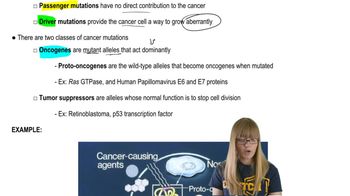Table of contents
- 1. Introduction to Genetics51m
- 2. Mendel's Laws of Inheritance3h 37m
- 3. Extensions to Mendelian Inheritance2h 41m
- 4. Genetic Mapping and Linkage2h 28m
- 5. Genetics of Bacteria and Viruses1h 21m
- 6. Chromosomal Variation1h 48m
- 7. DNA and Chromosome Structure56m
- 8. DNA Replication1h 10m
- 9. Mitosis and Meiosis1h 34m
- 10. Transcription1h 0m
- 11. Translation58m
- 12. Gene Regulation in Prokaryotes1h 19m
- 13. Gene Regulation in Eukaryotes44m
- 14. Genetic Control of Development44m
- 15. Genomes and Genomics1h 50m
- 16. Transposable Elements47m
- 17. Mutation, Repair, and Recombination1h 6m
- 18. Molecular Genetic Tools19m
- 19. Cancer Genetics29m
- 20. Quantitative Genetics1h 26m
- 21. Population Genetics50m
- 22. Evolutionary Genetics29m
17. Mutation, Repair, and Recombination
Types of Mutations
Problem 10
Textbook Question
In numerous population studies of spontaneous mutation, two observations are made consistently: (1) Most mutations are recessive, and (2) forward mutation is more frequent than reversion. What do you think are the likely explanations for these two observations?
 Verified step by step guidance
Verified step by step guidance1
span>Step 1: Understand the nature of recessive mutations. Recessive mutations often result in a loss of function of a gene product. Since most genes are present in two copies (alleles), the presence of one normal (dominant) allele can often compensate for the loss of function in the mutated allele, making the mutation recessive.</span
span>Step 2: Consider the genetic redundancy and buffering. Many organisms have genetic redundancy, where multiple genes can perform similar functions. This redundancy can buffer the effects of mutations, making them appear recessive.</span
span>Step 3: Explore the concept of forward mutation. Forward mutation refers to a change from a wild-type allele to a mutant allele. This is more common because there are many possible ways to disrupt a gene's function, leading to a mutant phenotype.</span
span>Step 4: Analyze the rarity of reversion mutations. Reversion, or back mutation, involves a change from a mutant allele back to the wild-type allele. This is less frequent because it requires a specific change that precisely restores the original sequence and function.</span
span>Step 5: Reflect on the implications of these observations. The prevalence of recessive mutations and the higher frequency of forward mutations suggest that genetic variation is often hidden in populations and that evolutionary change is more likely to occur through the accumulation of new mutations rather than the reversion of existing ones.</span
Recommended similar problem, with video answer:
 Verified Solution
Verified SolutionThis video solution was recommended by our tutors as helpful for the problem above
Video duration:
2mPlay a video:
Was this helpful?
Key Concepts
Here are the essential concepts you must grasp in order to answer the question correctly.
Recessive Mutations
Recessive mutations are genetic changes that do not manifest in the phenotype unless an individual has two copies of the mutated allele. This means that if a mutation is recessive, it can be carried by heterozygous individuals without affecting their observable traits. This characteristic leads to a higher prevalence of recessive mutations in populations, as they can persist without being selected against.
Recommended video:
Guided course

Cancer Mutations
Forward Mutation vs. Reversion
Forward mutation refers to the process by which a normal gene is altered to a mutant form, while reversion is the process where a mutant gene returns to its original state. Forward mutations are generally more frequent than reversions due to the nature of genetic changes, where many factors such as environmental stressors and replication errors can induce new mutations, whereas reverting to the original state is a more specific and less likely event.
Recommended video:
Guided course

Mutations and Phenotypes
Population Genetics
Population genetics is the study of genetic variation within populations and how these variations change over time due to factors like mutation, selection, gene flow, and genetic drift. Understanding population genetics is crucial for interpreting mutation rates and patterns, as it provides insights into how mutations can affect allele frequencies and the overall genetic structure of populations.
Recommended video:
Guided course

Descriptive Genetics

 9:49m
9:49mWatch next
Master Point Mutations with a bite sized video explanation from Kylia Goodner
Start learning


